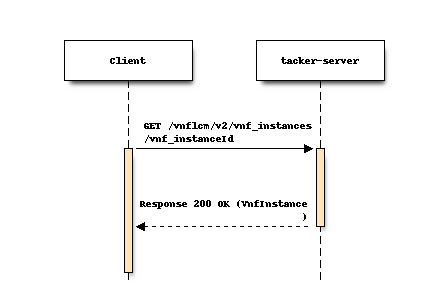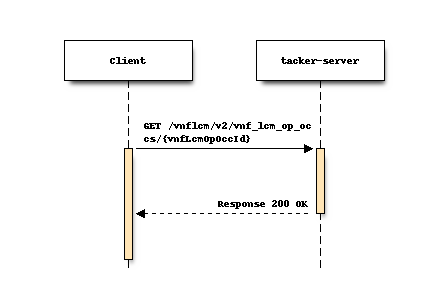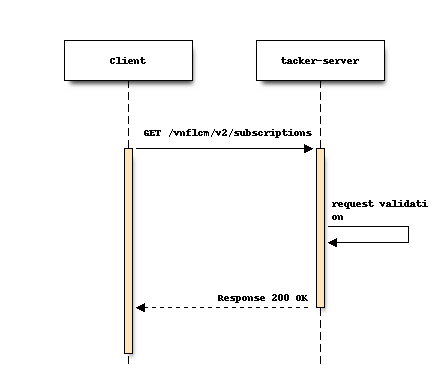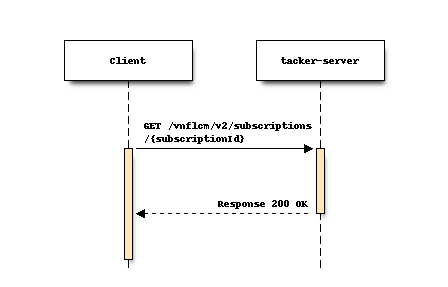Support NFV SOL_v3 getting LCM information¶
Blueprints:
https://blueprints.launchpad.net/tacker/+spec/support-nfv-solv3-query-vnf-instances
https://blueprints.launchpad.net/tacker/+spec/support-nfv-solv3-query-operation-occurrences
https://blueprints.launchpad.net/tacker/+spec/support-nfv-solv3-subscriptions
This specification supports a new version of VNF lifecycle management APIs complying with ETSI NFV SOL v3. It adds a new version of APIs involved in getting LCM information.
Problem description¶
ETSI specifications within the NFV Architecture Framework [1] describe the main aspects of NFV development and usage based on the industry needs, feedback from SDN/NFV vendors and telecom operators. These specifications include the REST API and data model architecture which is used by NFV users and developers in related products.
Support of key ETSI NFV specifications will significantly reduce efforts for Tacker integration into Telecom production networks and also will simplify further development and support of future standards. In Wallaby release, VNF lifecycle management operations defined in ETSI NFV SOL002 v2.6.1 [2] and SOL003 v2.6.1 [3] are supported. However, NFV continues to develop new specifications, it should comply with multiple versions of ETSI NFV SOL specification. Tacker will support VNF lifecycle management operations defined in ETSI NFV SOL002 v3.3.1 [4] and SOL003 v3.3.1 [5].
Proposed change¶
Since the VNF lifecycle management interface version specified in ETSI NFV SOL v3 is “2.0.0”, the API major version included in the URI shall be set to “v2”. Supporting v2 APIs involves changing the data type of some attributes and adding or removing attributes. To avoid impact on the existing implementation, APIs corresponding to “v2” should be implemented as a process independent of that of “v1”.
This interface supports the following APIs involved in getting information of lifecycle management operation.
List VNF Instances (GET /vnf_instances)
Show VNF Instances (GET /vnf_instances/{vnfInstanceId})
List VNF occurrence (GET /vnf_lcm_op_occs)
Show VNF occurrence (GET /vnf_lcm_op_occs/{vnfLcmOpOccId})
Create Subscriptions (POST /subscriptions)
List Subscriptions (GET /subscriptions)
Show Subscriptions (GET /subscriptions/{subscriptionId})
Delete Subscriptions (DELETE /subscriptions/{subscriptionId})
Notification endpoint (POST)
Test Notification endpoint (GET)
As shown in the below, there is no difference between flow of v1 API and that of v2 API.
1) Flow of the Query VNF operation¶
List VNF Instances (GET /vnf_instances)

The procedure consists of the following steps as illustrated in the above sequence:
Precondition: The resource representing the VNF instance has been created.
If the Client intends to query all VNF instances, it sends a GET request to the “VNF instances” resource with the API major version included in the URI is “v2”.
The VNFM returns a “200 OK” response including zero or more data structures of type “VnfInstance” in the payload body.
Show VNF (GET /vnf_instances/{vnfInstanceId})

The procedure consists of the following steps as illustrated in the above sequence:
Precondition: The resource representing the VNF instance has been created.
If the Client intends to read information about a particular VNF instance, it sends a GET request to the “Individual VNF instance” resource, addressed by the appropriate VNF instance identifier in its resource URI with the API major version included in the URI is “v2”.
The VNFM returns a “200 OK” response including one data structure of type “VnfInstance” in the payload body.
2) Flow of the Get Operation Status operation¶
List VNF occurrence (GET /vnf_lcm_op_occs)

The procedure consists of the following steps as illustrated in the above sequence:
The Client sends a GET request to the “VNF LCM operation occurrences” resource with the API major version included in the URI is “v2” and can use attribute-based filtering expression that follows clause 5.2 of ETSI GS NFV SOL013 [6].
The VNFM returns a “200 OK” response that includes zero or more data structures of type “VnfLcmOpOcc” in the payload body.
Show VNF occurrence (GET /vnf_lcm_op_occs/{vnfLcmOpOccId})

The procedure consists of the following steps as illustrated in the above sequence:
The Client sends a GET request to the “Individual VNF LCM operation occurrence” resource with the API major version included in the URI is “v2”, addressed by the appropriate VNF LCM operation occurrence identifier in its resource URI.
The VNFM returns a “200 OK” response to the Client, and includes one data structure of type “VnfLcmOpOcc” in the payload body.
3) Flow of managing subscriptions¶
Create Subscriptions (POST /subscriptions)
Test Notification endpoint (GET)

The procedure consists of the following steps as illustrated in the above sequence:
The Client sends a POST request to the “subscriptions” resource with the API major version included in the URI is “v2”.
The VNFM sends Notification to test the notification endpoint obtained from Create Subscription request.
The Client returns a “204 No Content” response to indicate success.
The VNFM returns a “201 Created” response.
List Subscriptions (GET /subscriptions)

The procedure consists of the following steps as illustrated in the above sequence:
The Client sends a GET request to the “subscriptions” resource with the API major version included in the URI is “v2”.
The VNFM returns a “200 OK” response that contains zero or more representations of all existing subscriptions that were created by the Client.
Show Subscriptions (GET /subscriptions/{subscriptionId})

The procedure consists of the following steps as illustrated in the above sequence:
The Client sends a GET request to the “subscriptions” resource with the API major version included in the URI is “v2”, addressed by the appropriate VNF LCM operation occurrence identifier in its resource URI.
The VNFM returns a “200 OK” response that contains a representation of that individual subscription.
Delete Subscriptions (DELETE /subscriptions/{subscriptionId})

The procedure consists of the following steps as illustrated in the above sequence:
The Client sends a DELETE request to the “subscriptions” resource with the API major version included in the URI is “v2”, addressed by the appropriate VNF LCM operation occurrence identifier in its resource URI.
The VNFM returns a “204 No Content” response if the subscription is successfully terminated.
4) Flow of sending notifications¶
- Notification endpoint (POST)
Precondition: Requesting Node has subscribed previously to notifications related to VNF lifecycle management.
When the LCM request is accepted, the operation status is sent to the consumer which registers subscription via “Subscription API”. This will be sent for the number of registrations.
The following operation states can be notified: STARTING/PROCESSING/COMPLETED/ROLLINGBACK/ROLLEDBACK/FAILED_TEMP
STARTING state is sent from Tacker Server, and other Operation_state notifications are sent from Tacker-Conductor.
Modify VNF does not send STARTING state.
Clients which received notification information sends “204 No Content” to Tacker.
Data model impact¶
In this SPEC with ETSI NFV SOL002 v3.3.1 [4] and SOL003 v3.3.1 [5], all defined attributes should be supported in API validation. Also, all data models in the response should be implemented in the Database to enable flexible change of logic in VNF lifecycle management.
From the above point of view, there are two motivations to change Database tables.
The first one is from supporting new attributes in v2 API. According to the SOL v3, new attributes were added from v2 API. However, the data model does not need to be changed because all new attributes are described in the current JSON data type.
The second one is from supporting all attributes defined in SOL documents. In v1 API, limited attributes are supported in API validation and stored in the Database. Database tables need to be changed to store additional supported attributes.
Below shows the Database tables for v2 API. As reference information, the difference with v1 API is also shown.
Note
Since Tacker manages a separate database for each major version, the design or the change of them does not affect each other.
VnfInstance
v1 API (vnf_instances)
v2 API (VnfInstanceV2)
Changes from v1 API
Data type
id
id
Data type changed
varchar(36) NOT NULL -> varchar(255) NOT NULL
vnf_instance_name
vnfInstanceName
Renamed
<no_changed>
vnf_instance_description
vnfInstanceDescription
Renamed and Data type changed
varchar(1024) DEFAULT NULL -> text DEFAULT NULL
vnfd_id
vnfdId
Renamed and Data type changed
varchar(36) NOT NULL -> varchar(255) NOT NULL
vnf_provider
vnfProvider
Renamed
<no_changed>
vnf_product_name
vnfProductName
Renamed
<no_changed>
vnf_software_version
vnfSoftwareVersion
Renamed
<no_changed>
vnfd_version
vnfdVersion
Renamed
<no_changed>
vnfConfigurableProperties
Added
json DEFAULT NULL
vim_connection_info
vimConnectionInfo
Renamed
<no_changed>
instantiation_state
instantiationState
Data type changed
varchar(255) NOT NULL -> enum(‘NOT_INSTANTIATED’,’INSTANTIATED’) NOT NULL
instantiatedVnfInfo
AddedinstantiatedVnfInfo field corresponding to vnf_instantiated_info in v1 API is merged in VnfInstanceV2 table and json data is stored directly.json DEFAULT NULL
vnf_metadata
metadata
Renamed
<no_changed>
extensions
Added
json DEFAULT NULL
task_state
Deleted
tenant_id
Deleted
vnf_pkg_id
Deleted
created_at
Deleted
updated_at
Deleted
deleted_at
Deleted
deleted
Deleted
VnfLcmOpOcc
v1 API (vnf_lcm_op_occs)
v2 API (VnfLcmOpOccV2)
Changes from v1 API
Data type
id
id
Data type changed
varchar(36) NOT NULL -> varchar(255) NOT NULL
operation_state
operationState
Renamed and Data type changed
varchar(16) DEFAULT NULL -> enum(‘STARTING’,’PROCESSING’,’COMPLETED’,’FAILED_TEMP’,’FAILED’,’ROLLING_BACK’,’ROLLED_BACK’) NOT NULL
state_entered_time
stateEnteredTime
Renamed
<no_changed>
start_time
startTime
Renamed
<no_changed>
vnf_instance_id
vnfInstanceId
Renamed and Data type changed
varchar(36) NOT NULL -> varchar(255) NOT NULL
grant_id
grantId
Data type changed
varchar(36) NOT NULL -> varchar(255) NOT NULL
operation
operation
Data type changed
varchar(16) DEFAULT NULL -> enum(‘INSTANTIATE’,’SCALE’,’SCALE_TO_LEVEL’,’CHANGE_FLAVOUR’,’TERMINATE’,’HEAL’,’OPERATE’,’CHANGE_EXT_CONN’,’MODIFY_INFO’,’CREATE_SNAPSHOT’,’REVERT_TO_SNAPSHOT’,’CHANGE_VNFPKG’) NOT NULL
is_automatic_invocation
isAutomaticInvocation
Renamed
<no_changed>
operation_params
operationParams
Renamed
<no_changed>
is_cancel_pending
isCancelPending
Renamed
<no_changed>
cancelMode
Added
enum(‘GRACEFUL’,’FORCEFUL’) DEFAULT NULL
error
error
<no_changed>
<no_changed>
resource_changes
resourceChanges
Renamed
<no_changed>
changed_info
changedInfo
Renamed
<no_changed>
changed_ext_connectivity
changedExtConnectivity
Renamed
<no_changed>
modificationsTriggeredByVnfPkgChange
AddedNew field defined SOL003 v3.3.1 [5] “F.2.1 FEAT02: VNF Software modification”.json DEFAULT NULL
vnfSnapshotInfoId
AddedNew field defined SOL003 v3.3.1 [5] “F.2.4 FEAT15: VNF snapshotting”.varchar(255) DEFAULT NULL
error_point
Deleted
created_at
Deleted
updated_at
Deleted
deleted_at
Deleted
deleted
Deleted
LccnSubscription
v1 API (vnf_lcm_subscriptions)
v2 API (LccnSubscriptionV2)
Changes from v1 API
Data type
id
id
Data type changed
varchar(36) NOT NULL -> varchar(255) NOT NULL
filter
AddedIn v2 API data model, filter field merged LccnSubscriptionV2 table.The filter field means vnf_lcm_filters table in v1 API.json DEFAULT NULL
callback_uri
callbackUri
Renamed
<no_changed>
verbosity
AddedNew field defined SOL003 v3.3.1 [5] “F.2.5.3 Verbosity of VNF LCM operation occurrence notifications”.enum(‘FULL’,’SHORT’) NOT NULL,
subscription_authentication
authentication
Renamed
<no_changed>
created_at
Deleted
updated_at
Deleted
deleted_at
Deleted
deleted
Deleted
REST API impact¶
In this SPEC with ETSI NFV SOL002 v3.3.1 [4] and SOL003 v3.3.1 [5], all defined attributes should be supported in API validation. Also, all data models in the response should be implemented in the Database to enable flexible change of logic in VNF lifecycle management.
The “_link” attribute is the only exception because not all operations in VNF lifecycle management interface are implemented. Some links to not implemented operations should be filtered.
- Name: List VNF instancesDescription: Query VNF instance resourceMethod type: GETURL for the resource: /vnflcm/v2/vnf_instancesURI query parameters supported by the GET method:
URI query parameter
Cardinality
Supported in API v2 (Xena)
Supported in API v1 (Wallaby)
filter
0..1
Yes
Yes
all_fields
0..1
Yes
No
fields
0..1
Yes
No
exclude_fields
0..1
Yes
No
exclude_default
0..1
Yes
No
nextpage_opaque_marker
0..1
Yes
No
Response:Data type
Cardinality
Response Codes
Description
VnfInstance
0..N
Success: 200
Information about zero or more VNF instances has been queried successfully.
ProblemDetails
1
Error: 400
Invalid attribute-based filtering expression.
ProblemDetails
1
Error: 400
Invalid attribute selector.
ProblemDetails
1
Error: 400
Response too big.
ProblemDetails
See clause 6.4 of [6]
Error: 4xx, 5xx
Any common error response code as defined in clause 6.4 of ETSI GS NFV-SOL 013 [6] may be returned.
Attribute name
Data type
Cardinality
Supported in API v2 (Xena)
Supported in API v1 (Wallaby)
Description
id
Identifier
1
Yes
Yes
vnfInstanceName
String
0..1
Yes
Yes
vnfInstanceDescription
String
0..1
Yes
Yes
vnfdId
Identifier
1
Yes
Yes
vnfProvider
String
1
Yes
Yes
vnfProductName
String
1
Yes
Yes
vnfSoftwareVersion
Version
1
Yes
Yes
vnfdVersion
Version
1
Yes
Yes
vnfConfigurableProperties
KeyValuePairs
0..1
Yes
No
vimConnectionInfo
map(VimConnectionInfo)
0..N
Yes
Yes
In API v2, the Data type is changed from VimConnectionInfo to map(VimConnectionInfo).
instantiationState
Enum
1
Yes
Yes
instantiatedVnfInfo
Structure (inlined)
0..1
Yes
Yes
>flavourId
IdentifierInVnfd
1
Yes
Yes
>vnfState
VnfOperationalStateType
1
Yes
Yes
>scaleStatus
ScaleInfo
0..N
Yes
Yes
>maxScaleLevels
ScaleInfo
0..N
Yes
not defined
New attribute in API v2.
>extCpInfo
VnfExtCpInfo
1..N
Yes
Yes
>extVirtualLinkInfo
ExtVirtualLinkInfo
0..N
Yes
Yes
>extManagedVirtualLinkInfo
ExtManagedVirtualLinkInfo
0..N
Yes
Yes
>monitoringParameters
MonitoringParameter
0..N
Yes
No
>localizationLanguage
String
0..1
Yes
No
>vnfcResourceInfo
VnfcResourceInfo
0..N
Yes
Yes
>vnfVirtualLinkResourceInfo
VnfVirtualLinkResourceInfo
0..N
Yes
Yes
>virtualStorageResourceInfo
VirtualStorageResourceInfo
0..N
Yes
Yes
>vnfcInfo
VnfcInfo
0..N
Yes
Yes
metadata
KeyValuePairs
0..1
Yes
Yes
extensions
KeyValuePairs
0..1
Yes
No
_links
Structure (inlined)
1
Yes
Yes
>self
Link
1
Yes
Yes
>indicators
Link
0..1
No
No
>instantiate
Link
0..1
Yes
Yes
>terminate
Link
0..1
Yes
Yes
>scale
Link
0..1
Yes
Yes
>scaleToLevel
Link
0..1
No
No
>changeFlavour
Link
0..1
No
No
>heal
Link
0..1
Yes
Yes
>operate
Link
0..1
No
No
>changeExtConn
Link
0..1
Yes
Yes
>createSnapshot
Link
0..1
No
not defined
New attribute in API v2.
>revertToSnapshot
Link
0..1
No
not defined
New attribute in API v2.
- Name: Show VNF instancesDescription: Query individual VNF instance resourceMethod type: GETURL for the resource: /vnflcm/v2/vnf_instances/{vnfInstanceId}Resource URI variables for this resource:
Name
Description
vnfInstanceId
Identifier of the vnfInstance.
Response:Data type
Cardinality
Response Codes
Description
VnfInstance
1
Success: 200
Information about an individual VNF instance has been read successfully.
ProblemDetails
See clause 6.4 of [6]
Error: 4xx, 5xx
Any common error response code as defined in clause 6.4 of ETSI GS NFV-SOL 013 [6] may be returned.
This API returns the data type of “VndInstance” in the payload body. Supported attributes of “VnfInstance” are the same as those of List VNF instances.
- Name: List VNF LCM operation occurrenceDescription: Request VNF lifecycle management operation occurrenceMethod type: GETURL for the resource: /vnflcm/v2/vnf_lcm_op_occsURI query parameters supported by the GET method:
URI query parameter
Cardinality
Supported in API v2 (Xena)
Supported in API v1 (Wallaby)
filter
0..1
Yes
Yes
all_fields
0..1
Yes
Yes
fields
0..1
Yes
Yes
exclude_fields
0..1
Yes
Yes
exclude_default
0..1
Yes
Yes
nextpage_opaque_marker
0..1
Yes
No
Response:Data type
Cardinality
Response Codes
Description
VnfLcmOpOcc
0..N
Success: 200
Status information for zero or more VNF lifecycle management operation occurrences has been queried successfully.
ProblemDetails
1
Error: 400
Invalid attribute-based filtering expression.
ProblemDetails
1
Error: 400
Invalid attribute selector.
ProblemDetails
1
Error: 400
Response too big.
ProblemDetails
See clause 6.4 of [6]
Error: 4xx, 5xx
Any common error response code as defined in clause 6.4 of ETSI GS NFV-SOL 013 [6] may be returned.
Attribute name
Data type
Cardinality
Supported in API v2 (Xena)
Supported in API v1 (Wallaby)
Description
id
Identifier
1
Yes
Yes
operationState
LcmOperationStateType
1
Yes
Yes
stateEnteredTime
DateTime
1
Yes
Yes
startTime
DateTime
1
Yes
Yes
vnfInstanceId
Identifier
1
Yes
Yes
grantId
Identifier
0..1
Yes
Yes
operation
LcmOperationType
1
Yes
Yes
isAutomaticInvocation
Boolean
1
Yes
Yes
operationParams
Object
0..1
Yes
Yes
isCancelPending
Boolean
1
Yes
Yes
cancelMode
CancelModeType
0..1
Yes
No
error
ProblemDetails
0..1
Yes
Yes
resourceChanges
Structure (inlined)
0..1
Yes
Yes
>affectedVnfcs
AffectedVnfc
0..N
Yes
Yes
>affectedVirtualLinks
AffectedVirtualLink
0..N
Yes
Yes
>affectedExtLinkPorts
AffectedExtLinkPort
0..N
Yes
not defined
New attribute in API v2.
>affectedVirtualStorages
AffectedVirtualStorage
0..N
Yes
Yes
changedInfo
VnfInfoModifications
0..1
Yes
Yes
changedExtConnectivity
ExtVirtualLinkInfo
0..N
Yes
Yes
modificationsTriggeredByVnfPkgChange
ModificationsTriggeredByVnfPkgChange
0..1
Yes
not defined
New attribute in API v2.
vnfSnapshotInfoId
Identifier
0..1
Yes
not defined
New attribute in API v2.
_links
Structure (inlined)
1
Yes
Yes
>self
Link
1
Yes
Yes
>vnfInstance
Link
1
Yes
Yes
>grant
Link
0..1
Yes
Yes
>cancel
Link
0..1
No
No
>retry
Link
0..1
Yes
Yes
>rollback
Link
0..1
Yes
Yes
>fail
Link
0..1
Yes
Yes
>vnfSnapshot
Link
0..1
No
No
- Name: Show LCM operation occurrenceDescription: Request VNF lifecycle management operation occurrenceMethod type: GETURL for the resource: /vnflcm/v2/vnf_lcm_op_occs/{vnfLcmOpOccId}Resource URI variables for this resource:
Name
Description
vnfLcmOpOccId
Identifier of a VNF lifecycle management operation occurrence.
Response:Data type
Cardinality
Response Codes
Description
VnfLcmOpOcc
1
Success: 200
Status information about a VNF lifecycle management operation occurrence.
ProblemDetails
See clause 6.4 of [6]
Error: 4xx, 5xx
Any common error response code as defined in clause 6.4 of ETSI GS NFV-SOL 013 [6] may be returned.
This API returns the data type of “VnfLcmOpOcc” in the payload body. Supported attributes of “VnfLcmOpOcc” are the same as those of List Lcm operation occurrence.
- Name: Create SubscriptionsDescription: Subscribe to notifications related to VNF lifecycle managementMethod type: POSTURL for the resource: /vnflcm/v2/subscriptionsRequest:
Data type
Cardinality
Description
LccnSubscriptionRequest
1
Parameters for the Subscription.
Attribute name
Data type
Cardinality
Supported in API v2 (Xena)
Supported in API v1 (Wallaby)
Description
filter
LifecycleChangeNotificationFilter
0..1
Yes
Yes
callbackUri
Uri
1
Yes
Yes
authentication
SubscriptionAuthentication
0..1
Yes
Yes
verbosity
LcmOpOccNotificationVerbosityType
0..1
Yes
not defined
New attribute in API v2.
Response:Data type
Cardinality
Response Codes
Description
LccnSubscription
1
Success: 201
The subscription has been created successfully.
ProblemDetails
1
Error: 422
The content type of the payload body is supported and the payload body of a request contains syntactically correct data but the data cannot be processed.
ProblemDetails
See clause 6.4 of [6]
Error: 4xx, 5xx
Any common error response code as defined in clause 6.4 of ETSI GS NFV-SOL 013 [6] may be returned.
Note
Tacker allows creating an “Individual subscription” resource if another “Individual subscription” resource with the same filter and callback URI already exists (in which case it shall return the “201 Created” response code).
Attribute name
Data type
Cardinality
Supported in API v2 (Xena)
Supported in API v1 (Wallaby)
Description
id
Identifier
1
Yes
Yes
filter
LifecycleChangeNotificationFilter
0..1
Yes
Yes
callbackUri
Uri
1
Yes
Yes
verbosity
LcmOpOccNotificationVerbosityType
0..1
Yes
not defined
New attribute in API v2.
_links
Structure (inlined)
1
Yes
Yes
>self
Link
1
Yes
Yes
- Name: List SubscriptionsDescription: Request to list all existing subscriptionsMethod type: GETURL for the resource: /vnflcm/v2/subscriptionsURI query parameters supported by the GET method:
URI query parameter
Cardinality
Supported in API v2 (Xena)
Supported in API v1 (Wallaby)
filter
0..1
Yes
Yes
nextpage_opaque_marker
0..1
Yes
Yes
Response:Data type
Cardinality
Response Codes
Description
LccnSubscription
0..N
Success: 200
The list of subscriptions has been queried successfully.
ProblemDetails
1
Error: 400
Invalid attribute-based filtering expression.
ProblemDetails
1
Error: 400
Response too big.
ProblemDetails
See clause 6.4 of [6]
Error: 4xx, 5xx
Any common error response code as defined in clause 6.4 of ETSI GS NFV-SOL 013 [6] may be returned.
This API returns the data type of “LccnSubscription” in the payload body. Supported attributes of “LccnSubscription” are the same as those of Create Subscriptions.
- Name: Query SubscriptionsDescription: Request to show individual subscription resource by its idMethod type: GETURL for the resource: /vnflcm/v2/subscriptions/{subscriptionId}Resource URI variables for this resource:
Name
Description
subscriptionId
Identifier of the subscriptions.
Response:Data type
Cardinality
Response Codes
Description
LccnSubscription
1
Success: 200
The operation has completed successfully.
ProblemDetails
See clause 6.4 of [6]
Error: 4xx, 5xx
Any common error response code as defined in clause 6.4 of ETSI GS NFV-SOL 013 [6] may be returned.
This API returns the data type of “LccnSubscription” in the payload body. Supported attributes of “LccnSubscription” are the same as those of Create Subscriptions.
- Name: Delete SubscriptionsDescription: Request to delete individual subscription resource by its idMethod type: DELETEURL for the resource: /vnflcm/v2/subscriptions/{subscriptionId}Resource URI variables for this resource:
Name
Description
subscriptionId
Identifier of the subscriptions.
Response:Data type
Cardinality
Response Codes
Description
n/a
Success: 204
The individual subscription resource has been deleted successfully.
ProblemDetails
See clause 6.4 of [6]
Error: 4xx, 5xx
Any common error response code as defined in clause 6.4 of ETSI GS NFV-SOL 013 [6] may be returned.
- Name: Notification endpointDescription: Send notifications related to VNF lifecycle changes
Note
This API is called from Tacker to the Client.
Method type: POSTURL for the resource: The resource URI is provided by the Client when creating the subscription.Request:Data type
Cardinality
Description
VnfLcmOperationOccurrenceNotification
1
A notification about lifecycle changes triggered by a VNF LCM operation occurrence.
VnfIdentifierCreationNotification
1
A notification about the creation of a VNF identifier and the related individual VNF instance resource.
VnfIdentifierDeletionNotification
1
A notification about the deletion of a VNF identifier and the related individual VNF instance resource.
VnfLcmOperationOccurrenceNotification
Attribute name
Data type
Cardinality
Supported in API v2 (Xena)
Supported in API v1 (Wallaby)
Description
id
Identifier
1
Yes
Yes
notificationType
String
1
Yes
Yes
subscriptionId
Identifier
1
Yes
Yes
timeStamp
DateTime
1
Yes
Yes
notificationStatus
Enum
1
Yes
Yes
operationState
LcmOperationStateType
1
Yes
Yes
vnfInstanceId
Identifier
1
Yes
Yes
operation
LcmOperationType
1
Yes
Yes
isAutomaticInvocation
Boolean
1
Yes
Yes
verbosity
LcmOpOccNotificationVerbosityType
0..1
Yes
not defined
New attribute in API v2.
vnfLcmOpOccId
Identifier
1
Yes
Yes
affectedVnfcs
AffectedVnfc
0..N
Yes
Yes
affectedVirtualLinks
AffectedVirtualLink
0..N
Yes
Yes
affectedExtLinkPorts
AffectedExtLinkPort
0..N
Yes
not defined
New attribute in API v2.
affectedVirtualStorages
AffectedVirtualStorage
0..N
Yes
Yes
changedInfo
VnfInfoModifications
0..1
Yes
Yes
changedExtConnectivity
ExtVirtualLinkInfo
0..N
Yes
Yes
modificationsTriggeredByVnfPkgChange
ModificationsTriggeredByVnfPkgChange
0..1
Yes
not defined
New attribute in API v2.
error
ProblemDetails
0..1
Yes
Yes
_links
LccnLinks
1
Yes
Yes
VnfIdentifierCreationNotification
Attribute name
Data type
Cardinality
Supported in API v2 (Xena)
Supported in API v1 (Wallaby)
Description
id
Identifier
1
Yes
Yes
notificationType
String
1
Yes
Yes
subscriptionId
Identifier
1
Yes
Yes
timeStamp
DateTime
1
Yes
Yes
vnfInstanceId
Identifier
1
Yes
Yes
_links
LccnLinks
1
Yes
Yes
VnfIdentifierDeletionNotification
Attribute name
Data type
Cardinality
Supported in API v2 (Xena)
Supported in API v1 (Wallaby)
Description
id
Identifier
1
Yes
Yes
notificationType
String
1
Yes
Yes
subscriptionId
Identifier
1
Yes
Yes
timeStamp
DateTime
1
Yes
Yes
vnfInstanceId
Identifier
1
Yes
Yes
_links
LccnLinks
1
Yes
Yes
Response:Data type
Cardinality
Response Codes
Description
n/a
Success: 204
The notification has been delivered successfully.
ProblemDetails
See clause 6.4 of [6]
Error: 4xx, 5xx
Any common error response code as defined in clause 6.4 of ETSI GS NFV-SOL 013 [6] may be returned.
- Name: Test Notification endpointDescription: The method allows the server to test the notification endpoint that is provided by the Client.
Note
This API is called from Tacker to the Client.
Method type: GETURL for the resource: The resource URI is provided by the Client when creating the subscription.Response:Data type
Cardinality
Response Codes
Description
n/a
Success: 204
The notification endpoint has been tested successfully.
ProblemDetails
See clause 6.4 of [6]
Error: 4xx, 5xx
Any common error response code as defined in clause 6.4 of ETSI GS NFV-SOL 013 [6] may be returned.
Note
If this API returns an error response, the Subscriptions API that triggers it will return a 400 error response.
Security impact¶
None
Notifications impact¶
None
Other end user impact¶
CLI options may be changed to switch between v1 API and v2 API.
Performance Impact¶
None
Other deployer impact¶
None
Developer impact¶
python-tackerclient needs to support a new attribute to set API version.
Implementation¶
Assignee(s)¶
Hirofumi Noguchi <hirofumi.noguchi.rs@hco.ntt.co.jp>
Work Items¶
Add new version API endpoints to Tacker-server.
Add new unit and functional tests.
Update the Tacker’s API documentation.
Dependencies¶
None
Testing¶
Unit and functional test cases will be added for VNF lifecycle management of VNF instances.
Documentation Impact¶
Complete user guide will be added to explain how to invoke VNF lifecycle management of VNF instances with examples.
